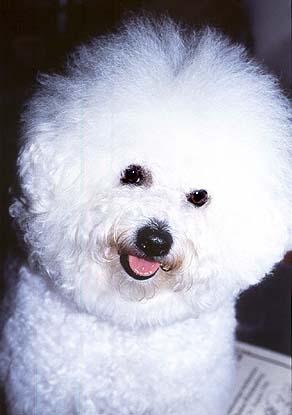Bichon Frisé - Bichon à poil Frisé
| Breed Description | Breed Standard | Gallery | Links |
 |
Bichon Frisé - FCI Breed Standard
| BICHON FRISE (Bichon à
poil frisé)
TRANSLATION : Mrs. Peggy Davis. ORIGIN : France and Belgium. DATE OF PUBLICATION OF THE VALID ORIGINAL STANDARD : 10.01.1972. UTILIZATION : Companion. CLASSIFICATION FCI : Group 9 Companions and toys Section 1 Bichons
GENERAL APPEARANCE : Lively and playful little dog, with a lively
gait, medium length muzzle, long corkskrew-curled very soft hair, very
like the
HEAD : The skull longer than the muzzle, the head in harmony
with the body.
NECK : Reach of neck is fairly long, carried high and proudly. Round and fine near the skull, broadening gradually to merge smoothly into the shoulders. Its length is very approximately a third of the length of the body (proportion of 11 cm to 33 cm for a dog of 27 cm high); the points of the shoulder against the withers taken as basis. SHOULDER : The shoulder is fairly slanted, not prominent, giving
the appearance of being the same length as the upper arm, about 10 cm;
does not
LEGS : Seen from the front, really straight and perpendicular;
fine bone; the pastern is short and straight seen from the front, very
slightly oblique seen
CHEST : Well developed; the sternum is pronounced; the false ribs rounded and do not end abruptly, the chest having horizontally a rather great depth. FLANKS : The flanks are well tucked up at the belly; the skin is fine and not loose, giving quite a whippety appearance. LOIN : Loin broad and well muscled, slightly arched. The pelvis is wide, the rump is slightly rounded and the tail is set a little more below the back line than in the Poodle. THIGHS : The thighs are broad and muscular; lower thighs slanting. The hock is also more angulated than in the Poodle; feet sinewy. TAIL : Normally the tail is carried high and gracefully curved
in line with the spine, without being rolled up; it is not docked and must
not be in contact
PIGMENTATION : The pigmentation beneath the white coat is preferably dark; the genitals are then pigmented either black, bluish or beige. COLOUR : Pure white. COAT (HAIR) : Fine, silky, very loose corkscrew curls looking like the coat (fur) of the Mongolian goat, neither flat nor corded and 7 to 10 cm long. GROOMING : The dog may be shown with the feet and muzzle slightly tidied up. SIZE : The height at the withers should not exceed 30 cm, the small size being an element of success. FAULTS : Any departure from the foregoing points should be considered a fault and the seriousness with which the fault should be regarded should be in exact proportion to its degree.
|
<< Home |
Homepage created by Woma, last Update 12. Apr. 1999 |
|
